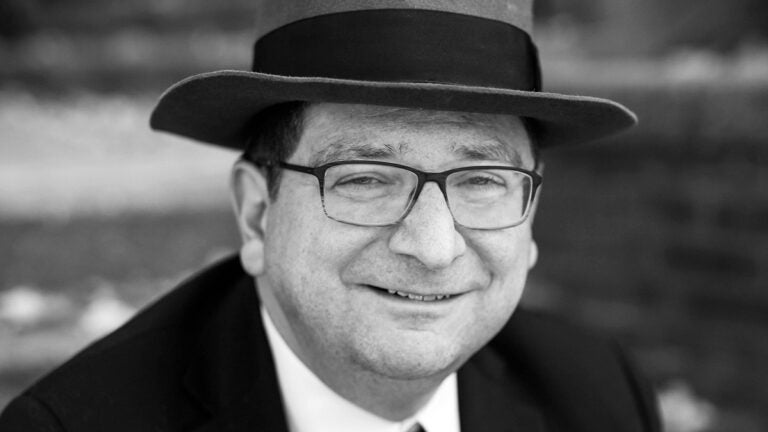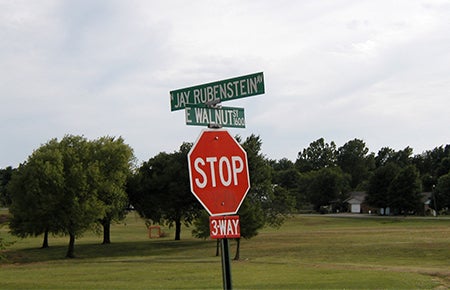
From Cushing Crude to the City of Angels: USC Dornsife’s new medieval scholar traces his unusual journey
Nothing predisposed Jay Rubenstein to become a medieval scholar.
The small Midwestern town of Cushing, Oklahoma, where he was born and raised, is a refining center, best known as a trading hub for crude oil. There, his parents ran a scrap metal and recycling company.
“In the summer, I would be in charge of the aluminum can machine,” Rubenstein recalls.
But when he wasn’t recycling cans, the American teen was nurturing an admiration for all things British, fueled by a deep love of the BBC sci-fi series Doctor Who and the music of British rock band The Kinks. By the time he had joined Carleton College in Northfield, Minnesota, as an undergraduate, Rubenstein was determined to spend a semester in England.
He focused on getting accepted into one of the only U.K. study-abroad programs available to him at Carleton — which happened to be at the University of Oxford’s Center for Medieval and Renaissance Studies. Realizing the program would be his golden ticket to England, Rubenstein took a medieval history class in preparation.
“For the first three quarters of the class I just hated it,” he recalls. “But then we read The Art of Courtly Love, a guidebook from the period on how to be a good lover in the Middle Ages.” As the class debated whether the art of courtly love had actually existed or was just an intellectual construct, Rubenstein was captivated.
Then he got to Oxford.
Discovering a new world
The oldest buildings in Cushing date from the 1920s, so the medieval city and its university were a revelation.
Oxford, he says “just struck me as dumbfoundingly beautiful. All of these gorgeous, medieval, Renaissance- and Enlightenment-era buildings, all crammed together in such a small city square. It was a stunning place to be.”
But Rubenstein says the moment he really became hooked was when he took a paleography class to learn how to read medieval handwriting. The final exam was held in an Oxford college library built in the early 17th century. The assignment? Translate a medieval manuscript.
“That was the first time I’d worked with an actual medieval book,” Rubenstein said. “Here I am with a pencil in hand, copying a book that somebody had copied out about 700 years ago with a quill pen. That gave me an electrifying sense of connection to the past.

“I still get a contact high every time I get to handle an old manuscript.”
His connection with Oxford flourished. A grant enabled him to return in the summer to research miracle cults. He wrote his senior thesis on the city’s patron saint.
A Rhodes Scholarship awarded during his senior year allowed him to return to Oxford as a postgraduate. His hometown was so excited by the news, they named a street — Jay Rubenstein Avenue — in his honor. The son of scrap metal merchants was on his way to a glittering academic career.
Centered on the premodern world
In 2007, Rubenstein was awarded a prestigious MacArthur Fellowship — popularly known as a “Genius Grant.” Following teaching posts at the University of New Mexico, Syracuse University, Dickinson College, and the University of Tennessee, Knoxville, he joined USC Dornsife in 2019 as professor of history, becoming department chair in August 2020. Last year, the distinguished medieval scholar became the director of USC Dornsife’s Center for the Premodern World, which had been launched at the request of faculty.
“It’s an exciting opportunity, because I get to build a center from the ground up and put my own stamp on it,” says Rubenstein, whose research focuses on the Crusades, apocalyptic thought, and religious and intellectual life in the Middle Ages.
He’s particularly excited by the fact the new center won’t be confined to Medieval Europe but will also embrace antiquity and pre-history. He is also looking forward to working with USC Dornsife faculty in classics, art history, history, religion and East Asian studies.
“I think job one of a center like this is to get as many people as possible from different departments talking to one another, exchanging ideas and sharing some of their mutual interests,” Rubenstein said.
The center has maintained a full slate of programming this year, despite the challenges of the pandemic. Key events have included seminars on the premodern Mediterranean, held in conjunction with the USC-Huntington Early Modern Studies Institute; knightly culture in the Holy Land and during the Crusades; and iconoclasm in the premodern and modern worlds, including the destruction of monuments in the ancient world.
In the spring, the center will hold an event in partnership with USC Dornsife’s Center for the Political Future on conspiracy theories, medieval and modern.
“Reading about QAnon, I thought these widespread beliefs about conspiracies are going to survive the elections, whatever the outcome,” Rubenstein says. “It also startled me, just how similar these modern conspiracy theories are to medieval ideas, that you find the same tropes coming up — the pederasty, the anti-Semitism.”
Next fall, the center is planning to hold a major exhibition on the Silk Road in collaboration with Doheny Library.
Other projects include establishing a summer program for scholars of the premodern world, major outreach to the public and the wider academic community via campus-wide events, and the creation of research symposia in conjunction with The Getty.
Rigor and accessibility
Rubenstein strives to present academic research in a way that remains accessible to a wider audience.
“I want to use the center as a forum for figuring out ways to write well and with intellectual rigor but also in a way that will enable what we’re doing to be of interest to the wider world.”
He is clearly meeting that goal with his own writing. The late Terry Jones of Monty Python fame, himself an author of a tome on medieval history, described Rubenstein’s 2011 book Armies of Heaven: The First Crusade and the Quest for Apocalypse (Basic Books) as “a page-turner” and “the most fascinating and readable book about the Crusades I have read.”
Rubenstein’s latest book, Nebuchadnezzar’s Dream: The Crusades, Apocalyptic Prophecy and the End of History (Oxford University Press, 2019), explores how people in the Middle Ages thought about the first Crusade in connection with the apocalypse. He’s now planning a third volume on the Crusader Kingdom of Jerusalem.
“The question that will drive the narrative is, okay, you fulfilled the apocalypse, you’ve captured Jerusalem, now what do you do with it?” he says.
Changing places
Rubenstein spent four years in Oxford, one in Rome and four in Paris where he lived at “possibly the best address in the whole world — 13 rue Edgar Poe.”
Now he’s traded life in some of the world’s most historic cities for a post in arguably its most relentlessly modern metropolis: Los Angeles. As a medievalist, how is he adapting to living in the archetypal 20th-century city?
From an academic perspective, he says the fact that L.A. is home to both The Getty and The Huntington Library, Art Museum, and Botanical Gardens means he’s fortunate to have major historical resources at his fingertips.
Rubenstein also claims a personal affinity with the City of Angels. Citing Raymond Chandler’s The Long Goodbye as his favorite book, he reveals that while in Paris he developed a passion for old American cinema, particularly noir films of the 1930s and ’40s.
“So now coming to L.A. makes perfect sense. This is exactly where I want to be living right now. I love all the Googie architecture; I love all the neon.”
One thing is certain: When campus reopens, Rubenstein will be easy to spot. He has a predilection for wide-brimmed hats that he says would make him look right at home in a Humphrey Bogart movie.
This article, which originally appeared in October 2019, has been updated for the Fall 2020/Winter 2021 issue of USC Dornsife Magazine.